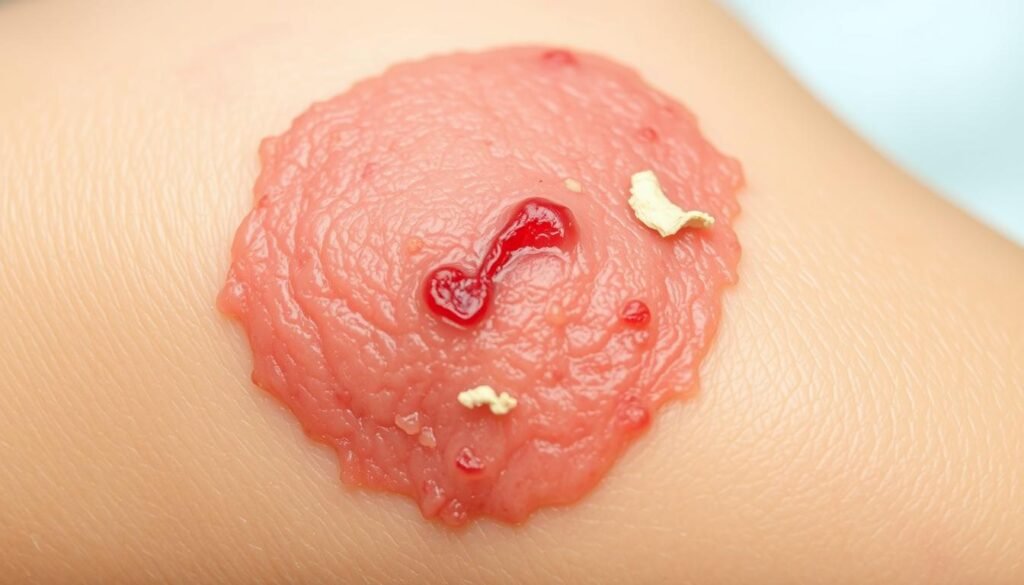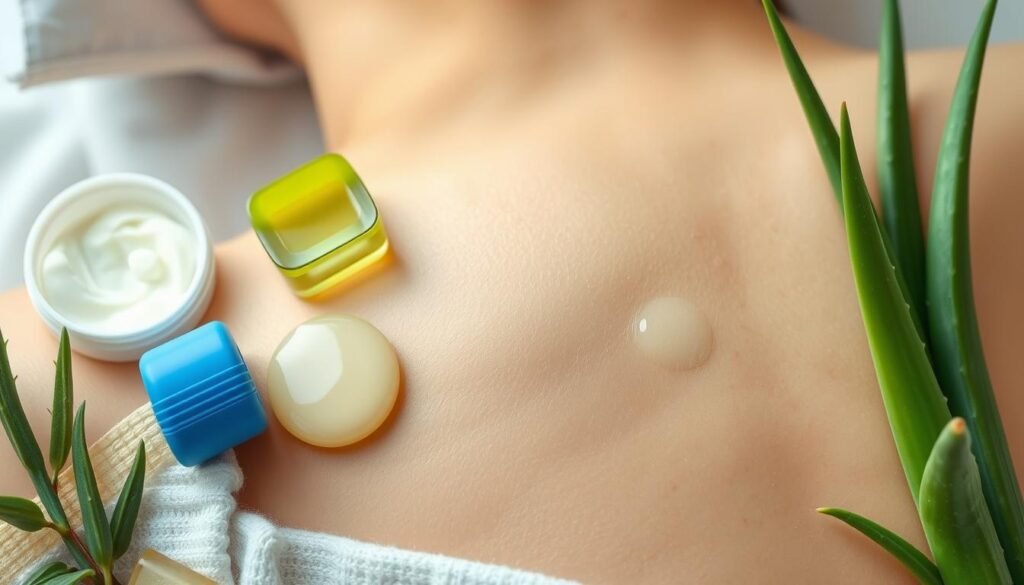Did you know around 95% of patients feel skin issues during radiation therapy? These can be redness, dryness, or sensitivity. This really affects their daily lives. Handling Skin Irritation After Radiation Treatment can seem hard. It’s tough when you’re facing itching and skin color changes. Knowing about these issues early and taking good care of your skin is key.
It’s important to get what causes these side effects and how everyone’s skin is different. Talking with healthcare pros to make a personal skin care plan is vital. This helps patients deal with skin issues from radiation. They feel better and keep their skin healthy during treatment.
Key Takeaways
- The majority of patients experience skin reactions during radiation therapy.
- Skin changes can include redness, dryness, and itchiness, peaking two weeks after treatment.
- Adopting a tailored skin care routine can significantly enhance comfort.
- Early recognition of symptoms allows for timely management and better outcomes.
- Loose-fitting, breathable clothing can help protect sensitive skin areas.
- Continuous communication with healthcare providers is essential for effective care.
Understanding Radiation Dermatitis
Radiation dermatitis is a skin problem. It affects about 95% of people getting radiation therapy for cancer. It’s a reaction to radiation exposure. Symptoms vary from mild to severe, graded from 1 to 4.
What is Radiation Dermatitis?
It occurs when radiation aimed at cancer cells harms healthy skin. It’s common on the head, neck, breast, and near the anus. Factors like age, poor nutrition, and smoking can increase risk. More radiation and longer treatment make symptoms worse.
Common Symptoms of Radiation-Induced Skin Reactions
The symptoms can include:
- Redness
- Itching and swelling
- Dryness and peeling
- Blistering or skin necrosis in severe cases
Early symptom recognition is key. Use gentle lotions, calamine, and oatmeal baths to ease pain. Avoid scratching. Get medical help for severe skin issues. For more on treating radiation burns, see this resource.
| Grade | Symptoms |
|---|---|
| 1 | Dry desquamation with generalized erythema |
| 2 | Moist desquamation without bleeding |
| 3 | Moist desquamation with bleeding |
| 4 | Ulcers, bleeding, and skin necrosis |
Side Effects of Radiation Therapy
Radiation therapy helps fight various cancers. However, it often leads to side effects like fatigue, nausea, and skin issues. Knowing these side effects helps patients manage the treatment phase better.
Overview of Radiation Therapy Side Effects
Most side effects from radiation therapy get better a few months after treatment ends. Early effects include fatigue and skin changes. These usually go away in weeks. Late side effects can occur months or years later, affecting normal tissue. The risk depends on the treated area and the radiation dose.
How Skin Tolerance Varies Among Patients
How radiation affects the skin varies greatly between patients. Factors such as radiation type, treatment area, and pre-existing skin conditions play a role. Skin issues like redness, swelling, or dryness tend to improve after treatment. For those treated around the head or neck, certain drugs can lessen side effects, showing how reactions can differ.

Factors Influencing Radiation Skin Toxicity
Patients react differently to radiation therapy. Knowing what affects radiation skin toxicity helps tailor better treatments. The area treated and the radiation dose matter a lot, as do any health issues that make skin more sensitive.
Role of Treatment Area and Radiation Dose
The treatment area is a big factor in skin reactions. Thinner skin or areas with more movement can get hurt more. The amount of radiation used is also crucial. Higher doses tend to cause stronger reactions.
Studies show that 85% to 95% of patients see skin damage from radiotherapy. This shows why personalized care is essential to reduce harm.
Pre-existing Conditions Affecting Skin Reactions
Conditions like diabetes or autoimmune diseases can change how skin reacts to radiation. They may slow down healing and increase skin damage. Spotting these factors influencing radiation skin toxicity early helps in handling them better. Knowing a patient’s health history helps healthcare teams pick suitable treatments.
Research stresses good skin care to prevent radiation therapy complications. It’s important for healing and for the patient’s well-being.
| Factor | Impact on Skin Reactions |
|---|---|
| Treatment Area | Higher risk in thinner skin regions |
| Radiation Dose | Increased dose correlates with worse reactions |
| Pre-existing Conditions | Conditions like diabetes increase sensitivity |
Find more strategies in the article on managing skin irritation after radiation. It offers evidence-based tips for patient care.
Dealing with Skin Irritation After Radiation Treatment
After radiation, skin may get red, swollen, and itchy, much like a sunburn. How severe these signs are can depend on the dose of radiation and your skin’s sensitivity. Noticing these early on is key for dealing with the discomfort during recovery.
Initial Symptoms and Recognizing Skin Changes
It’s important for cancer treatment patients to watch for skin changes. Key symptoms to keep an eye on include:
- Redness and irritation that may feel warm when you touch it.
- Itching or pruritus, which can be due to different reasons such as dry skin.
- Dryness, flaking, or peeling requiring the use of soft soaps and creams.
- Moist reactions in folds of skin that might lead to infections.
Knowing what symptoms to look for helps talk to doctors better. This helps in getting the right care fast.
Importance of Early Management
Starting care early is key to easing the discomfort from skin reactions. Don’t wait to talk to your healthcare team if you notice any changes. Using a good skincare routine helps healing, keeping skin moist and safe.
Skincare tips for those getting radiation can vary. Advice from your healthcare team can really help with faster recovery.

Skin Care During Radiation Treatment
After radiotherapy, taking care of your skin is crucial. This means cleaning and moisturizing your skin often. It eases discomfort and helps your skin heal better.
Guidelines for Skin Maintenance
To keep your skin healthy during treatment, there are some important tips to follow. These steps help protect your skin:
- Gently wash with soft, unscented soap to prevent more irritation.
- Put on a thick moisturizer right after showering while skin is damp. This helps keep moisture in.
- Choose loose clothes from soft materials like cotton. It reduces rubbing on sensitive skin.
- Steer clear of harsh products, including lotions, ointments, and makeup, on treated areas.
- Avoid direct sunlight. Wear protective clothes and use sunscreen with SPF 30 if you must be outside.
Recommended Soaps and Moisturizers
It’s important to pick the right skin care products after radiotherapy. Some brands are known for being gentle and effective:
| Product Type | Recommended Brands | Key Features |
|---|---|---|
| Soap | Cetaphil, Dove, Aveeno | Mild, unscented, non-irritating |
| Moisturizer | CeraVe, Neutrogena, Eucerin | Hydrating, fragrance-free, restores skin barrier |
Doctors often stress the need to keep up with these skin care steps. This is true during treatment and for weeks after. Doing this helps manage irritation and supports recovery.
Effective Radiation Dermatitis Treatment Options
To manage radiation dermatitis well, a detailed plan is needed, especially for skin reactions during and after therapy. Many topical treatments help ease pain and heal skin. Knowing when to get medical help is crucial to avoid more skin problems.
Topical Treatments for Skin Reactions
Topical treatments are key for handling radiation dermatitis. Here are some options:
- Hydrocortisone Cream: It reduces swelling and itching.
- Aloe-Based Products: These soothe and moisturize sore skin.
- Silver Leaf Nylon Dressings: They are good for their germ-fighting properties and help wounds heal.
- Zinc Ointment: It is good for making a protective cover for the skin.
Using these topical solutions can make patients more comfortable and help them recover faster. It’s important to talk regularly with doctors to find the best treatment for each person.
When to Seek Medical Help
It’s important for patients to watch out for signs that they need a doctor. These include:
- More redness or swelling in the treated spot
- Blistering or open sores
- Severe pain or discomfort that home treatments can’t fix
Not paying attention to these signs can cause worse skin problems or infections. Spotting these signs early helps doctors adjust treatments for better skin health.
For more about how radiation therapy works on lung tumors, you can look at this resource.

| Treatment Options | Description | Effectiveness |
|---|---|---|
| Hydrocortisone Cream | Reduces inflammation and itching | High |
| Aloe-Based Products | Soothes and moisturizes irritated skin | High |
| Silver Leaf Nylon Dressings | Antibacterial and wound healing support | Moderate |
| Zinc Ointment | Creates a protective skin barrier | Moderate |
Strategies for Radiation Burn Management
Managing radiation burns needs care that focuses on comfort and healing. Patients can use different methods to ease soreness. They should also follow recovery steps to help their skin get better after treatment.
Comfort Techniques for Sore Skin
To ease discomfort, try these methods:
- Wear loose-fitting, soft clothing to minimize irritation on the treated area.
- Apply cool compresses to soothe the skin and relieve pain.
- Utilize over-the-counter pain relief options, as needed, to manage acute pain.
- Avoid scratching or rubbing the affected area, which can exacerbate discomfort.
- Stay hydrated by drinking plenty of water, helping skin recovery from within.
Long-Term Skin Recovery Tips
To keep your skin healthy after a radiation burn, consider these tips:
- Continue skincare routines even after radiation therapy, focusing on moisturizing with emollients to support skin restoration.
- Monitor the treated area for changes, such as increased redness or blistering, and inform healthcare providers immediately if concerns arise.
- Practice gentle cleansing techniques, using lukewarm water and mild soap while avoiding harsh skin products.
- Be vigilant about protecting the treated skin from sunlight exposure, which can hinder the healing process.
- Regularly check for symptoms of infection, such as fever or unusual drainage, and seek medical attention if these occur.
Radiodermatitis Prevention Techniques
To prevent radiodermatitis in patients getting radiation therapy, daily skin care is key. It’s important to moisturize often with emollients to lessen skin reactions. Patients should use mild soaps to avoid further skin irritation.
Keeping the skin hydrated is also crucial for its protection. Applying moisturizers multiple times a day helps keep the skin healthy during treatment.
Daily Skin Care Routines
Adding protective steps to daily care can greatly help in preventing radiodermatitis. Before going out in the sun, patients should use sunscreen with high SPF. This is because UV rays can make skin problems worse.
Wearing loose and breathable clothes can reduce irritation on treated skin areas. It’s also smart to stay away from harsh weather to lessen skin irritation. This helps skin heal better after treatment.
Protecting Skin from Environmental Factors
The environment affects our skin a lot, especially during radiation therapy. Creating a protective environment cuts down the risk of radiodermatitis. Drinking plenty of water and eating healthy foods boost skin health.
Learning about skin care empowers patients and helps prevent skin issues. Talking with healthcare professionals about the best skin products is also beneficial. This improves overall wellness in the long run.